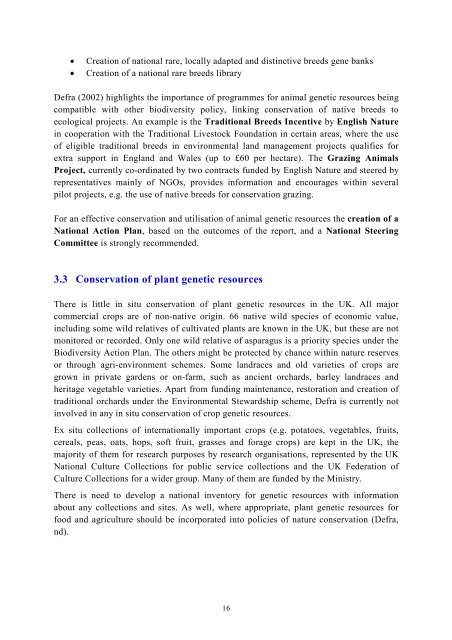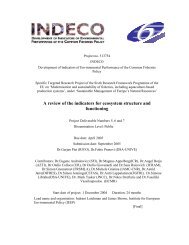WP5 Case study on genetic resources in food and agriculture
WP5 Case study on genetic resources in food and agriculture
WP5 Case study on genetic resources in food and agriculture
Create successful ePaper yourself
Turn your PDF publications into a flip-book with our unique Google optimized e-Paper software.
• Creati<strong>on</strong> of nati<strong>on</strong>al rare, locally adapted <strong>and</strong> dist<strong>in</strong>ctive breeds gene banks• Creati<strong>on</strong> of a nati<strong>on</strong>al rare breeds libraryDefra (2002) highlights the importance of programmes for animal <strong>genetic</strong> <strong>resources</strong> be<strong>in</strong>gcompatible with other biodiversity policy, l<strong>in</strong>k<strong>in</strong>g c<strong>on</strong>servati<strong>on</strong> of native breeds toecological projects. An example is the Traditi<strong>on</strong>al Breeds Incentive by English Nature<strong>in</strong> cooperati<strong>on</strong> with the Traditi<strong>on</strong>al Livestock Foundati<strong>on</strong> <strong>in</strong> certa<strong>in</strong> areas, where the useof eligible traditi<strong>on</strong>al breeds <strong>in</strong> envir<strong>on</strong>mental l<strong>and</strong> management projects qualifies forextra support <strong>in</strong> Engl<strong>and</strong> <strong>and</strong> Wales (up to £60 per hectare). The Graz<strong>in</strong>g AnimalsProject, currently co-ord<strong>in</strong>ated by two c<strong>on</strong>tracts funded by English Nature <strong>and</strong> steered byrepresentatives ma<strong>in</strong>ly of NGOs, provides <strong>in</strong>formati<strong>on</strong> <strong>and</strong> encourages with<strong>in</strong> severalpilot projects, e.g. the use of native breeds for c<strong>on</strong>servati<strong>on</strong> graz<strong>in</strong>g.For an effective c<strong>on</strong>servati<strong>on</strong> <strong>and</strong> utilisati<strong>on</strong> of animal <strong>genetic</strong> <strong>resources</strong> the creati<strong>on</strong> of aNati<strong>on</strong>al Acti<strong>on</strong> Plan, based <strong>on</strong> the outcomes of the report, <strong>and</strong> a Nati<strong>on</strong>al Steer<strong>in</strong>gCommittee is str<strong>on</strong>gly recommended.3.3 C<strong>on</strong>servati<strong>on</strong> of plant <strong>genetic</strong> <strong>resources</strong>There is little <strong>in</strong> situ c<strong>on</strong>servati<strong>on</strong> of plant <strong>genetic</strong> <strong>resources</strong> <strong>in</strong> the UK. All majorcommercial crops are of n<strong>on</strong>-native orig<strong>in</strong>. 66 native wild species of ec<strong>on</strong>omic value,<strong>in</strong>clud<strong>in</strong>g some wild relatives of cultivated plants are known <strong>in</strong> the UK, but these are notm<strong>on</strong>itored or recorded. Only <strong>on</strong>e wild relative of asparagus is a priority species under theBiodiversity Acti<strong>on</strong> Plan. The others might be protected by chance with<strong>in</strong> nature reservesor through agri-envir<strong>on</strong>ment schemes. Some l<strong>and</strong>races <strong>and</strong> old varieties of crops aregrown <strong>in</strong> private gardens or <strong>on</strong>-farm, such as ancient orchards, barley l<strong>and</strong>races <strong>and</strong>heritage vegetable varieties. Apart from fund<strong>in</strong>g ma<strong>in</strong>tenance, restorati<strong>on</strong> <strong>and</strong> creati<strong>on</strong> oftraditi<strong>on</strong>al orchards under the Envir<strong>on</strong>mental Stewardship scheme, Defra is currently not<strong>in</strong>volved <strong>in</strong> any <strong>in</strong> situ c<strong>on</strong>servati<strong>on</strong> of crop <strong>genetic</strong> <strong>resources</strong>.Ex situ collecti<strong>on</strong>s of <strong>in</strong>ternati<strong>on</strong>ally important crops (e.g. potatoes, vegetables, fruits,cereals, peas, oats, hops, soft fruit, grasses <strong>and</strong> forage crops) are kept <strong>in</strong> the UK, themajority of them for research purposes by research organisati<strong>on</strong>s, represented by the UKNati<strong>on</strong>al Culture Collecti<strong>on</strong>s for public service collecti<strong>on</strong>s <strong>and</strong> the UK Federati<strong>on</strong> ofCulture Collecti<strong>on</strong>s for a wider group. Many of them are funded by the M<strong>in</strong>istry.There is need to develop a nati<strong>on</strong>al <strong>in</strong>ventory for <strong>genetic</strong> <strong>resources</strong> with <strong>in</strong>formati<strong>on</strong>about any collecti<strong>on</strong>s <strong>and</strong> sites. As well, where appropriate, plant <strong>genetic</strong> <strong>resources</strong> for<strong>food</strong> <strong>and</strong> <strong>agriculture</strong> should be <strong>in</strong>corporated <strong>in</strong>to policies of nature c<strong>on</strong>servati<strong>on</strong> (Defra,nd).16




